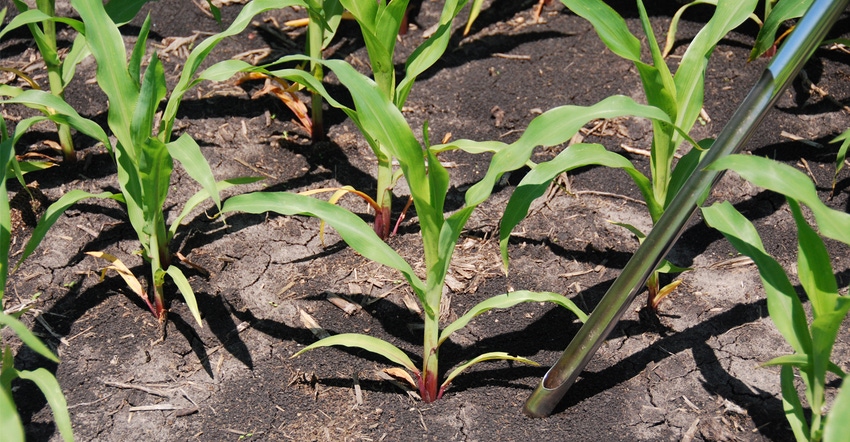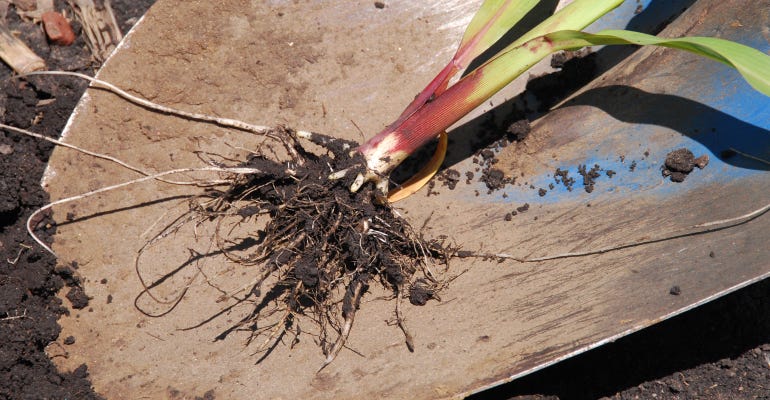June 19, 2019

As Iowa’s corn crop gets established in 2019, it’s time to turn thoughts toward pests. Plant parasitic nematodes that feed on corn roots can cause damage and yield loss. Some nematode species are damaging to corn at very low population densities. But most species are not harmful until population densities reach many hundreds or more per 100 cubic centimeters (a little less than a half-cup) of soil. And there are some nematode species that are not thought to be harmful to corn at all.
It’s not likely that healthy-looking corn is being damaged by plant-parasitic nematodes, says Greg Tylka, Iowa State University Extension plant pathologist. So, not every field in Iowa needs to be sampled for nematodes that feed on corn.
Sampling leads to better decisions
Increased sampling for nematodes that feed on corn will lead to a better understanding of the importance of these native pests in corn production in Iowa. And information from such samples will help farmers and those who advise them to make better-informed decisions concerning the use of current and future nematode management products.
It’s common for Iowa fields to have several different species of plant-parasitic nematodes present at low numbers, says Tylka, who conducts research on both corn and soybean nematodes. See a summary of results of testing for nematodes that feed on corn in Iowa from 2000 to 2010
Sampling to check for damaging levels of nematodes must be done during the growing season — ideally when symptoms of damage are seen. Tylka provides the following guidelines on how to collect samples for assessing the potential for damage and yield loss caused by nematodes that feed on corn.
Type of sample to collect
Soil and root samples should be collected up until corn growth stage V6, Tylka says:
Use a soil probe to collect cores that are at least 12 inches long.
Collect 20 or more soil cores to represent an area.
Collect soil cores from within the root zones of plants with symptoms of damage.
Combine (but do not mix) the soil cores and place them in a sealed plastic bag labeled with a permanent marker.
Collect, with a shovel, the root mass from four to six plants with symptoms of damage. Take care not to strip off the smaller seminal roots. The tops of the plants can be cut off and discarded. Place the roots in a sealed plastic bag labeled with a permanent marker.
Protect the samples from physical jarring and keep the samples cool (room temperature or below).

TIMING: Soil samples can be collected for nematode testing between V6 growth stage (young corn plants) and R3 (milk stage) during the growing season.

From corn growth stage V6 through R3 (milk), collect only soil samples, not the roots.
Use a soil probe and collect cores that are at least 12 inches long.
Collect 20 or more soil cores to represent an area.
Collect soil cores from within the root zones of plants showing symptoms of damage. Combine (but do not mix) the soil cores and place them in a sealed plastic bag labeled with a permanent marker.
Protect the samples from physical jarring and keep the samples cool (room temperature or below).
From corn growth stage R4 (dough) to harvest, sampling is not recommended, Tylka says. There isn’t a reliable relationship between damage or yield loss, and the number of nematodes present in soil and roots once the corn crop reaches the R4 growth stage. Therefore, sampling is not recommended after that point in the growing season.
Where to send samples
Several private laboratories, and most land-grant university plant diagnostic labs or plant disease clinics process samples, and identify and count the numbers of plant-parasitic nematodes present. Here’s a link to a list of the university laboratories and their contact information.
The ISU facility's location and address is Plant and Insect Diagnostic Clinic, Room 2445, Advanced Teaching and Research Building, 2213 Pammel Drive, Iowa State University, Ames, IA 50011-1101.
The test for nematodes that feed on corn from the ISU Plant and Insect Diagnostic Clinic is called the “complete nematode count.” Samples sent to the ISU Clinic should be accompanied by a Nematode Sample Submission Form (ISU Extension Publication PIDC 32) and a check for the $35 per sample processing fee ($45 per sample for out-of-state samples).
Management options
If damaging population densities of nematodes are found in a field, there is nothing that can be done during the current growing season to limit the buildup of nematode numbers and lessen the yield loss, Tylka says.
Management options for future corn crops include use of soil-applied Counter 20G nematicide or seed treatments such as Aveo, Avicta, Escalate, Nemastrike, Trunemco and Votivo. Use of these management options must be decided upon before the corn crop is planted.
Source: ISU, which is responsible for information provided and is wholly owned by the source. Informa Business Media and its subsidiaries aren’t responsible for any content in this information asset.
You May Also Like




